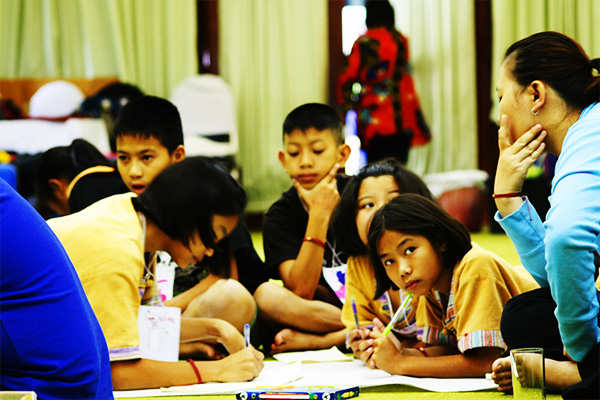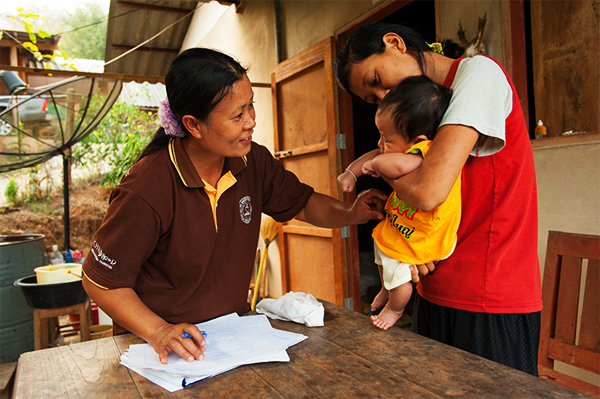CityNews – The World Health Organisation (WHO) statistics state that Thailand not only has the highest prevalence of HIV/AIDS in Asia, but also shows one of the highest infection rates in the world behind South Africa, Nigeria, and India.
 The Life Skills Development Foundation (TLSDF) – Youth capacity-building workshop
The Life Skills Development Foundation (TLSDF) – Youth capacity-building workshop
Despite anti-HIV campaigns running for more than two decades and the number of HIV/AIDS cases falling, the rate of infections we are told is on the rise again, and northern Thailand is home to the highest density of infections. The reason that the number of infections remains high says WHO is because in spite of campaigns and promotion of condom use HIV/AIDS, premarital sex and sex with prostitutes without contraception, is still very widespread.
In northern Thailand, in particular within indigenous communities, the rate of HIV/AIDS is alarming. Infection can be ruinous in many ways to a family, even if they have access to life saving drugs. The disease is stigmatised, so much so that often an infected person, and their family, might be ostracised from the village to which they belonged. Biological concerns then become ancillary to practical survival issues as families find themselves without resources to make a living and often feed their children.
Jessica Scalzo, who works at the centre in Chiang Mai, explained that, “In engaging local communities, training indigenous and minority groups in career and life skills, we have had huge success.”
She adds that their emphasis is on training and sustainability, and that after TLSDF has been in a community one year enough locals should have been trained and the organisation can leave, although Sclazo stresses, “The one year refers to our management of day care centres as part of the Early Childhood Care and Development – ECCD-programme. We may work with the same community for multiple years and we consistently work with the same youth groups on leadership skills and UN CRC knowledge.” She reiterates that sustainability and self-sufficiency are key factors. TLSDF doesn’t completely withdraw at the end of a project cycle, rather they conduct follow-ups to ensure a smooth transition.
“There’s a fine line with what we can do,” she says, “we don’t want to completely change local traditions,” but such things as HIV awareness, health education, teaching job skills, parenting skills, Thai/English language acquisition skills, is well within the parameters of what they deem necessary education without encroaching on customs and traditions.

Health volunteer home visits to families with newborns and young children (ECCD programme)
Kreangkrai Chaimuangdee, Executive Director of TLSDF, explained that rates of HIV/AIDS in northern Thailand are still very high. “490,000 Thais are believed to be infected, or 2% of the population,” which he says is an improvement on the past, but it’s believed that 40% of these cases are in 6 provinces of upper northern Thailand.
Once a family member is infected it can mean complete ostracisation from the community, which could also mean a loss of resources greatly affecting the ability to generate an income and social underdevelopment of children. While the centre works on helping infected families with things like access to Anti-retroviral drugs (ARVs), and teaching “income generating activities” their emphasis is on silencing a stigma that causes so much harm to infected persons and their families.
“If someone is found to be HIV positive they might get expelled from the tribe or community,” says Krengkrai. “This has a momentous affect on children.” He explains that the kids are often treated with suspicion or banned from interacting with other children, even if it is their parents who are infected. While outreach centres have helped reduce instances of ostracising, it is still not enough says Krengkrai, partly because “indigenous populations are not a priority on the child rights agenda in Thailand.”
“We are trying to teach families to overcome stigma,” he explains, adding that many people belonging to indigenous populations are not aware of how the disease is spread. He says that in the past people were so afraid of HIV that they would “wait until they were sick to get the blood test”, but in more recent times, thanks to stigma being quelled somewhat, more families are taking the test.
Daylin Paul, a South African born photographer presently working on a multi-media project with TLSDF, explains that “there’s a kind of superstitious fear” that surrounds the disease, and that in ignorance of empirical medical facts communities might tend to be irrational about how the disease is spread.
Paul is presently working on a project whereby he spends a significant amount of time with a HIV infected woman and her family in upper northern Thailand. The family will remain unidentifiable because of the stigma attached to the disease, but by living side by side, by being there through the working day and in the evening Paul hopes to capture pieces of life that will be helpful not only to TLSDF but to other organisations in the future. He will, if you like, become a fly on the wall of a family struggling with limited money and a mother who lives on in spite of her infection.
Paul, who comes from KwaZulu-natel in South Africa told us: “I come from the place which has the highest rate of HIV/AIDS in World,” adding that around 39% of people living in his province are HIV positive.
“I’d be working in jobs and people would just be disappearing. I grew up around HIV, and so it’s something I’m interested in.”
He talks about the woman he spends time with when he’s in the countryside: “She works really hard, farming pigs,” he says, a ‘sustainable’ income supplied to her by TLSDF. “I just shoot all day,” Paul adds, “and hopefully when it’s finished what I come up with will be helpful to the centre, it will be helpful to anyone interested in helping people living with HIV.”
Child rights, health awareness, family planning issues, are very much matters of grave concern in northern Thailand where much of the population lives in poverty and without access to what might be considered advanced education.
Scalzo talks about the need for more “networking” between NGOs and “international conferences”.
“We want to develop a coalition,” she says, “which will improve communications and collaboration within Thailand and with other country coalitions. Thailand was the only SE Asian country without a child rights coalition until TLSDF joined the Child Rights Coalition of Asia (CRC Asia) organization, but even then Thailand lacks a formal national one.” The coalition, she explains, would be able to give civil society Alternative Reports directly to the UN, separate from government reports which she says might not be able to report accurately on matters such as child rights. This coalition, she says, is still a work in progress. As is, of course, the rights of children in Thailand.